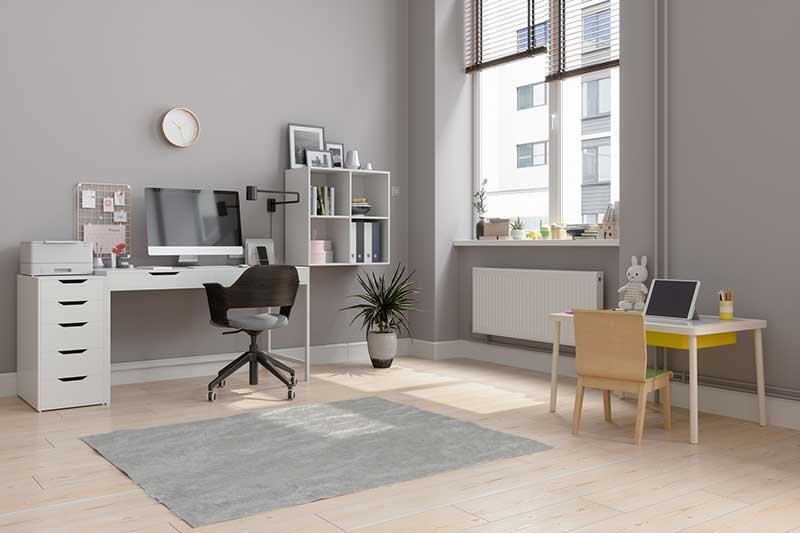Creating a Productive Workspace and Study Space at Home

August 29, 2024
SEB Marketing Team
Many modern homes are blurring the lines between personal and professional with remote work and children who need a place to study. Creating a versatile and productive space that serves as both a workspace for parents and a study area for kids can be a practical and essential solution for many. Here are some considerations for creating a versatile and productive environment that serves both parents and children, ensuring that everyone has the ideal space to thrive.
Designing a Multi-Functional Space
Choosing the Right Location: Although traditionally homework might be done at the kitchen table, it might be more ideal to select an area free from high traffic and distractions, yet central enough to easily transition between work and study sessions. Considering that this space will be used for work during the day and for studying in the evening, a spare bedroom, corner or the living room or an unused dining room table might strike the balance between accessibility and privacy. Whatever the choice, the key is to find a spot that can be easily adapted throughout the day. Then define the space with either an area rug, color-coded bins or certain lighting choices that can be swapped out easily to change from a professional to an educational space. This helps everyone mentally change gears.
Versatile Furniture: If it is reasonable, consider investing in furniture pieces that can serve multiple functions and easily transition from a work setup to a study environment. For instance, a sit/stand desk can double as both a work and study surface, while adjustable chairs can be modified to fit the ergonomic needs of both adults and children. Shelving units, possibly with wheels and both closed and open storage options can help organize work material during the day and study supplies in the evening. Another option might be tall bookcases that can store what is not being used. Items could be placed in bins for easy access to both children and adults.
Lighting Consideration: Proper lighting supports both productivity and eye comfort. Consider using LED lighting that offers adjustable brightness and color temperature to suit different activities throughout the day. Desk lamps that include built-in USB chargers can be particularly useful, providing a convenient way to keep devices charged without cluttering the workspace with extra cords. These lamps are also energy-efficient, reducing electricity consumption while ensuring that your workspace is well-lit.
Plants: Incorporating plants into the space can enhance your wellbeing and productivity because plants such as Snake plants are both low maintenance and air purifiers. Plants don’t just improve air quality; they can also reduce stress and are an affordable way to add a touch of nature to your environment.
Productive Workspace for Parents in the Morning
Ergonomic Setup: A productive workspace starts with comfort and ergonomics. Investing in an ergonomic chair provides proper lumbar support and helps maintain focus and prevent strain during long work hours. Pair this with a desk that offers enough space for your tech essentials, such as a computer, keyboard, and mouse, as well as options to stand and sit as needed. Adjusting the height of your workspace periodically throughout the day keeps a sense of movement and flexibility to the body and mind.
Tech Essentials: Technology is at the heart of a home office. Ensure your space is equipped with the necessary tools to maintain productivity. A good internet connection, noise-canceling headphones, a second monitor and cable management solutions all help improve the aesthetics while reducing stress and keeping things organized. Consider also investing in a docking station to easily switch between work and personal devices.
Organizers: Desktop calendars can help keep the whole family organized. Not only can they help you prioritize tasks, set achievable goals, and manage your time effectively, but they can also communicate activities, events and deadlines for the whole family. Consider giving each family member a color to make them stand out on the calendar. balance, especially when working from home.
Study Space for Kids in the Evening
Transitioning the Space: At the end of the workday, it’s time to transition the space for your children’s study time. Clear away work-related items to create a clutter-free environment that helps your kids focus. A clean desk will make it easier for them to dive into their homework or creative projects without distraction. If using bins, make sure they are within reach of your child.
Kid-Friendly Environment: Make the study space inviting for children by incorporating elements that cater to their needs. Adjust chair or desk settings to fit their size. Perhaps change out the plants or allow them their own desk organizer to make the space feel like theirs. Consider fun additions such as a globe or a whiteboard for brainstorming. Even colorful wall art can help personalize the space and make it more kid-friendly while keeping the goal on focus and productivity.
Creating a dual-purpose space that serves both as a workspace for parents and a study area for children is an investment in your family’s productivity and wellbeing. By carefully selecting the location, using versatile furniture, and optimizing your home’s layout, you can design a space that supports both work and learning. The time you spend organizing and planning will pay off in improved focus, reduced stress, and a more flexible living environment.
Post navigation
Related Posts

3 Keys to Sustainable Excellence of High-Performance Teams
You spent a considerable amount of capital and time hiring the best engineers, the most…

Your 5-Point Generative AI Policy Checklist for HR and Tech Leaders.
C'est officiel : l'Intelligence Artificielle générative (IAg) n'est plus un concept futuriste—c'est un super copilote…

The Psychological Safety Re-Check: Why Even Top Teams Need a Periodic Vulnerability Audit
You’ve built a rockstar team. They hit their numbers and they crush their goals. Congratulations!…
